Archaeological excavations
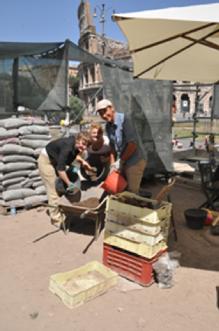 |
|
Abigael Flack, Lois Norris and Maciej Jaszczynski at work, in the background the Colosseum. |
As a department we are happy to organise archaeological fieldwork experience for those who are interested. Once students arrive at Warwick they can contact Suzanne Frey-Kupper for placement opportunties, or respond to the emails sent from both staff and current students about opporunities throughout the year.
Nicholas Aherne in Policastro (Italy), Summer 2019.
This summer I participated in a month long archaeological placement in the coastal town of Policastro in South Italy. Although I had been on a couple of excavations prior to this, Policastro was my first classical one. All in all it was a fantastic experience.
Policastro was settled by Greek colonists in the 6th/5th c. BC and today sill exhibits ruins from Greek, Roman and medieval times. In recent years the team working here had been excavating within the original Greek fortification walls, with particular focus on a Roman necropolis and a Roman thermal bath dating to 3rd/4th c AD.
This year excavating continued in rooms attached to the bath complex. Identifying all of their functions is difficult as a medieval tannery was built directly on top of them and modern machinery has unfortunately damaged the stratigraphy. One of the most interesting finds was a mosaic in one of the back rooms and another important discovery was a Roman road.
Excavating in 30 degree heat is not easy but the end result is very rewarding. It is always exciting to uncover new material, knowing that I am the first person to have seen/held such an artefact for centuries, sometimes even millenia. When I was not excavating I was carrying out post-excavation tasks in the pottery lab. Here I catalogued primarily pottery but also glass, mosaic tesserae, and bones. By being exposed to these materials day in day out, I have become far more confident in identifying their class, type etc. Drawing the finds was probably my favourite part of this process. The most fascinating artefact in the lab was a fragment of a 90cm diameter ‘louterion’. This beautifully decorated, pre-Roman basin may have been used for a religious purposes. Additionally at the lab for the first time I was shown how to digitalise a site map, its phases and layers, aided by a drone, total station and GPS.
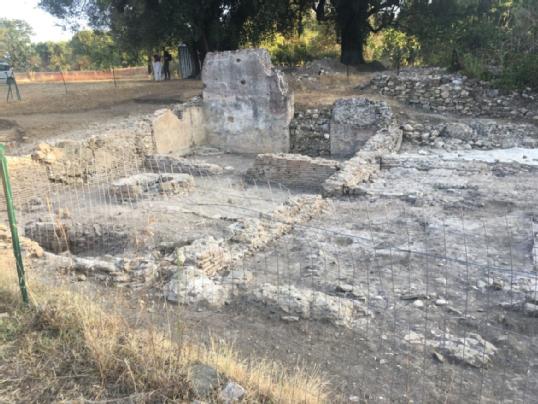 |
 |
The site at Policastro.
The placement also involved weekend trips to historical sites such as Paestum, Herculaneum, a local cave complex and museums. Being able to apply what I learned during my lectures at Warwick to the artefacts and sites I came across in Italy was extremely gratifying. One of the main reasons I applied for this placement was to learn the archaeological methodologies of a different country, which have proved interesting. For me this trip has also reinforced the importance of learning languages when working in fields such as classics and archaeology. Not only are the majority of sources related to the sites which we explored in Italian but vital information can be lost when a multicultural team are communicating. I plan to continue adding to my Italian vocabulary (Latin helps a lot!) to aid me in my further studies and projects.
I am very grateful to Grampus and the Italian teams for this opportunity to develop my skills and broaden my knowledge, and to all if my lecturers at Warwick for cultivating my passion for classics and archaeology.
Dillon Patel in Pompeii, regio 7, insula 14 - Summer 2018
Dillon has been awarded an Archaeology placement to be trained in excavation and postexcavation skills during one month, see below his report. This was funded by the European Achaeology Skills Exchange under the Erasmus+ programme, a scheme run by PEATS-Grampus Heritage represented at Warwick by Suzanne Frey-Kupper.

'I took part in archaeological excavations through the entire month of July in Italy on the ancient city of Pompeii. A complete novice to archaeology, I worked as part of an international team to excavate a section of shops dated below the 79AD eruption layer. This was an incredible experience that satisfied my passion for archaeology in such a famous historical context.
My role involved using traditional methods of archaeology to discover different layers and catalogue the finds. It was amazing to be right at the heart of the action seeing artefacts come out of the ground for the first time in almost 2000 years! I was introduced to digital mapping of the layers and the site to create a vivid and accurate plan alongside aiding the production of the Harris-Matrix. When not on excavation, I was involved in the Pottery and Fresco labs where my team worked to restore and clean them pieces found on site.
The placement involved some cultural trips allowing me to pick up a little Italian whilst visiting the famous sites of Paestum and Pompeii’s sister site Herculaneum. Alongside this, I was thrilled to see the Naples Archaeological Museum with an abundance of beautiful art and artefacts. Many of the pieces seen I would go on to recognise in lecture! It was extremely rewarding seeing the final process stemming from excavation.
It was overall an incredible experience and one I will always treasure. I am eternally grateful for Prof. Suzanne Frey-Kupper for her help in finding the placement and my personal tutor Dr. Elena Giusti for aiding my application, and Grampus Heritage for organising the placement.'
A snapshot of archaeological experience:
Three students of the Classics Department have been over summer on the prestigious excavation on the north-eastern slope of the Palatine in Rome directed by Professor Clementina Panella assisted by Dott. Giacomo Pardini, Università La Sapienza, Rome. The experience is all the more valuable as the Warwick students have been working with Italian students.
Suzanne Frey-Kupper who has been invited to this collaboration warmly thanks her colleagues of the Sapienza.
Here is a section of the students' report:
‘In July, after my first year of studies in Classics I had the opportunity to participate in the excavations on the north-east slope of the Palatine Hill in Rome, directed by Professor Clementina Panella from the University La Sapienza. These two weeks were my first ever excavation and it turned out to be a very valuable experience. Two other students from Warwick's Classics Department also participated in the dig, Abigael Flack and Lois Norris.
The excavated area covers about 4000 m2 and is the biggest ongoing excavation in Rome. Its aim is to reconstruct the spatial organisation of this part of the city, which was completely unknown before the project. Several very important finds have been discovered in this area: the Augustan fountain known as ‘Meta’ in the sources, a sanctuary identified as Romulus' ‘Curiae Veteres’ and the forth century A.D. insignia discovered in 2005. We worked mainly on the Neronian
and Flavian levels. While removing the soil I noticed a floor in opus signinum which turned out to be quite big, beautiful and very well preserved. Dating back to the Late Republican period it was used up to the Neronian fire in AD 64 (see below, middle).
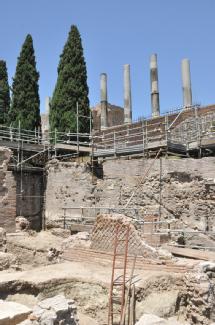
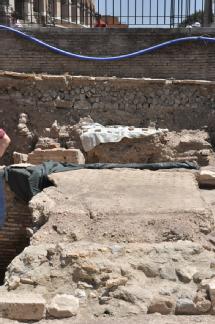
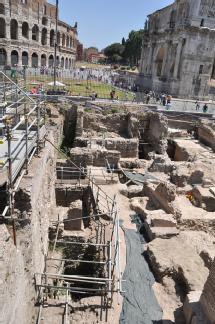
This was a very important experience for me, even though I am a ‘classicist’ rather than an ‘archaeologist’, interested more in literature and language than in material culture. I have seen how literature and archaeology work together to identify structures and objects and how these sources complement each other. Moreover, a detailed knowledge of the area will be very useful to me, since I am studying ‘The Roman Empire from Tiberius to Hadrian’ module this year.
In addition, we had the opportunity to see how studying in Italy differs from that in UK.
I am very happy that I had such a great opportunity to experience archaeological excavations and to learn many new things working in the heart of the Roman Empire. I really enjoyed that time. I really enjoyed that time and I would like to thank my personal tutor, Dr Suzanne Frey-Kupper, for making it possible and for a few Italian lessons.’
Maciej Jaszczynski
